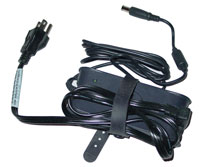Dell Inspiron 6000(d)
Construction: Field Tested
|
Charger – For the past couple of years, Dell has stuck with the same power brick. It remains to be one of the better charger designs on the market, particularly with the strap design that allows you to tie up extra cabling and the straight power plug that has thus far always been plugged into a port on the back of the notebook.
Display – Dell offers three 15.4" display options: WXGA (native 1280 x 800), WSXGA+ UltraSharp(native 1680 x 1050), and WUXGA UltraSharp (native 1920 x 1200). Our sample came with configured with the WXGA, which is the base line option. Upgrading to WSXGA+ UltraSharp or WUXGA UltraSharp runs $125 and $175, respectively. Our recommendation is to go with either of the higher end solutions. For most people WXGA isn't going to be enough working space and for some reason, we were unable to emulate larger desktop resolutions with the current ATI driver set via the Dell support site. Of course, choosing a UltraSharp display has other benefits too, as these displays actually do have wider viewing angles and more vibrant colors via the higher contrast ratio. Basically, these are the displays that we have come to love on Dell notebooks, and we recommend not settling for anything less.
The highest setting (8) is fairly bright, but the UltraSharp displays are obviously brighter and more brilliant and we believe they have more brightness settings available, which may help extend battery life. The lowest brightness setting is bright enough to use in a dark room without making it too much of a strain on the eyes, but we feel more comfortable in using one brightness setting up. AC and battery power share the same brightness settings.
Fan - For about 90% of the time we were running the notebook, it was dead quiet, even though the fan was running. The fan on this notebook is a variable speed fan, like the other notebooks on the market. The difference is that there happens to be a larger fan in use here, and even when it is on at "normal" speed, it is barely louder than the hard drive hum. Dell definitely got it right here.
Heat – After about two hours of use, the notebook was still cool to the touch all around, even the keyboard spot above the GPU and the chassis bottom near the CPU. As far as we could tell, the only spot that got even slightly warm was the right-middle bottom where the hard drive is situated. Other than that you can't even tell the computer is on if it wasn't for the LEDs and the slight hum of the CPU fan and the hard drive hum.







